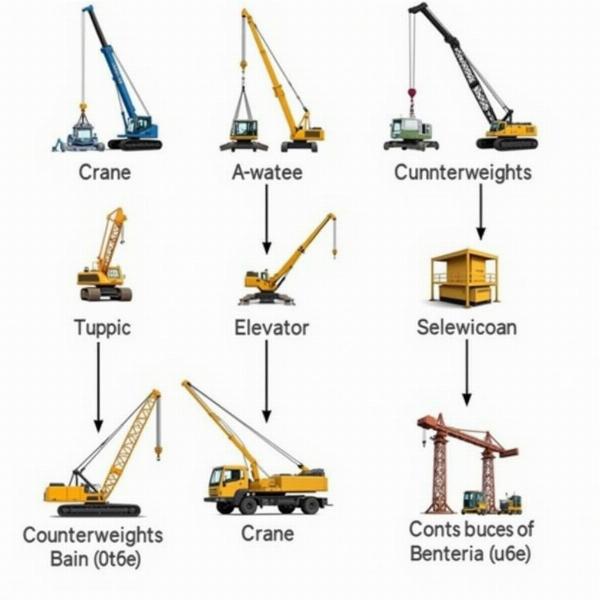Understanding the meaning of “counterweight” in Hindi is crucial for various technical, legal, and everyday contexts. Whether you’re dealing with machinery, legal documents, or simply trying to grasp the concept in a Hindi conversation, this guide will provide you with a clear and comprehensive explanation of “counterweight meaning in Hindi.” We’ll explore its various translations, synonyms, and practical applications.
Understanding “Counterweight” in Different Contexts
The English word “counterweight” refers to a weight used to balance another weight, often in a mechanical system. It acts as an opposing force to stabilize or control movement. In Hindi, this concept can be expressed through several terms, each with slightly nuanced meanings.
Common Hindi Translations of “Counterweight”
- प्रतिभार (Pratibhaar): This is perhaps the most common and direct translation of “counterweight.” It literally means “opposite weight” and accurately captures the core concept.
- संतुलन भार (Santulan Bhar): This term emphasizes the balancing aspect of a counterweight, meaning “balancing weight.” It’s often used in contexts where stability is the primary concern.
- विपरीत भार (Viparit Bhar): Meaning “opposite weight,” this term highlights the opposing force exerted by the counterweight.
- तौल (Taul): While “taul” generally refers to weight, it can sometimes be used in a context implying a counterbalancing weight, especially in colloquial Hindi.
 Counterweight Examples in Machinery
Counterweight Examples in Machinery
Practical Applications of Counterweights
Counterweights are essential in a wide range of applications, from simple everyday objects to complex machinery.
Counterweights in Engineering and Machinery
In engineering, counterweights are crucial for stability and control. Cranes, elevators, and drawbridges all rely on counterweights to function safely and efficiently. Imagine a crane lifting a heavy load; without a counterweight, the crane would tip over.
Counterweights in Everyday Life
You encounter counterweights more often than you think, even in everyday life. A traditional see-saw utilizes the principle of counterweights to allow children to play. Even some types of window blinds use counterweights to control their movement.
Choosing the Right Hindi Term for “Counterweight”
The best Hindi term to use depends on the specific context. For technical documents, “Pratibhaar” is usually the most appropriate choice. In more casual conversations, “Santulan Bhar” or even “Taul” might suffice.
Counterweights in Legal and Technical Documents
When translating legal or technical documents, accuracy is paramount. Using the correct Hindi term for “counterweight” is essential to avoid misunderstandings and ensure the document’s validity. “Pratibhaar” is generally preferred in these formal settings.
What if there’s no counterweight?
Imagine a swing set without anyone on the other side. It becomes difficult to maintain balance, right? Similarly, many systems rely on counterweights to function correctly. Without them, stability is compromised, and the system might become unsafe or inefficient.
Conclusion
Understanding “counterweight meaning in Hindi” allows you to communicate effectively in various situations. Whether you’re discussing technical specifications, translating legal documents, or simply explaining a concept in everyday conversation, choosing the appropriate Hindi term is essential. From “Pratibhaar” for technical precision to “Santulan Bhar” for general conversations, this guide has equipped you with the knowledge to use these terms correctly. Remember, the correct translation can make all the difference in clarity and understanding.
FAQ
- What is the most common Hindi word for “counterweight”? Pratibhaar (प्रतिभार) is the most common and direct translation.
- Can “Taul” be used to mean “counterweight”? Yes, in some colloquial contexts, “Taul” can imply a counterbalancing weight.
- Why are counterweights important in engineering? Counterweights are crucial for stability and control in machinery like cranes and elevators.
- Where can I find examples of counterweights in everyday life? See-saws, some window blinds, and traditional wells use the principle of counterweights.
- Which term should I use in legal documents? “Pratibhaar (प्रतिभार)” is generally preferred for formal and legal documents.
- What happens if there is no counterweight? Systems without counterweights can become unstable and potentially unsafe.
- Where can I get professional Hindi translation services? Contact Meaning-Hindi.in for accurate and reliable Hindi translation services.
Looking for professional Hindi translation services?
Meaning-Hindi.in is your trusted partner for high-quality Hindi translation and localization services. We specialize in various domains, including business, legal, technical, website, and academic translations. Our team of expert linguists ensures accurate and culturally sensitive translations tailored to your specific needs. Contact us today for a free quote! Email: [email protected], Phone: +91 11-4502-7584. Learn more about our services at Meaning-Hindi.in.